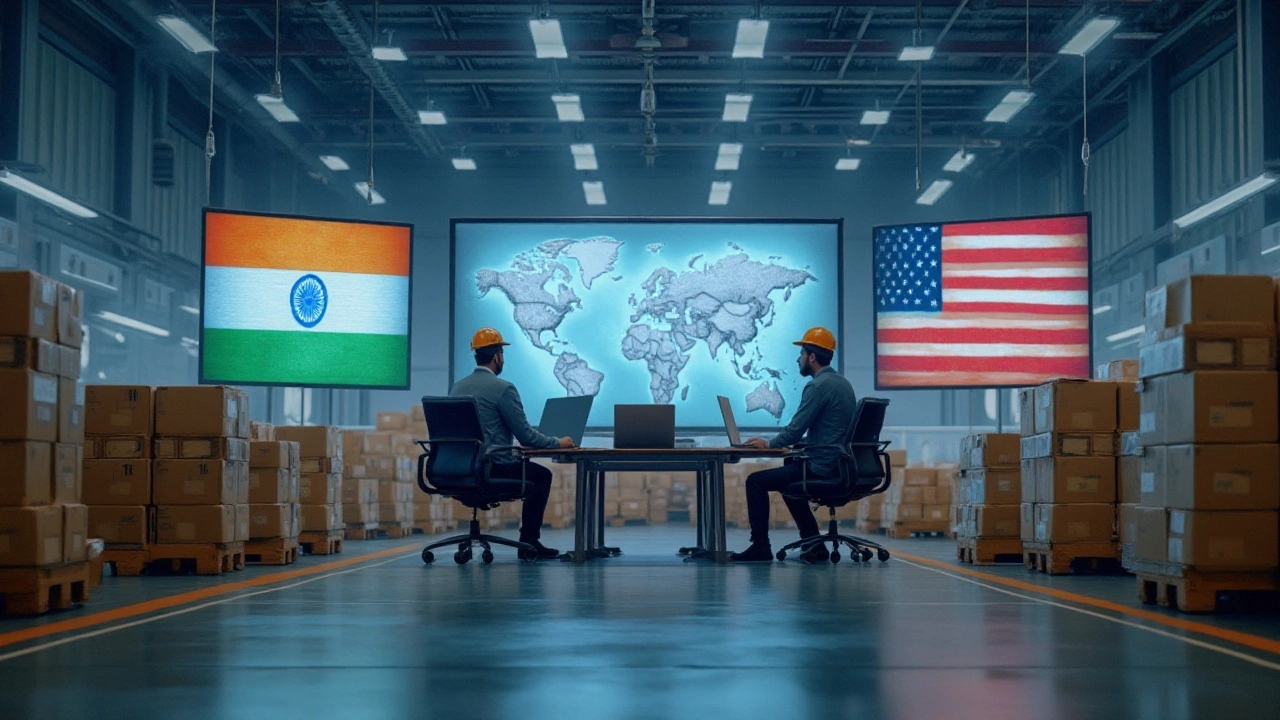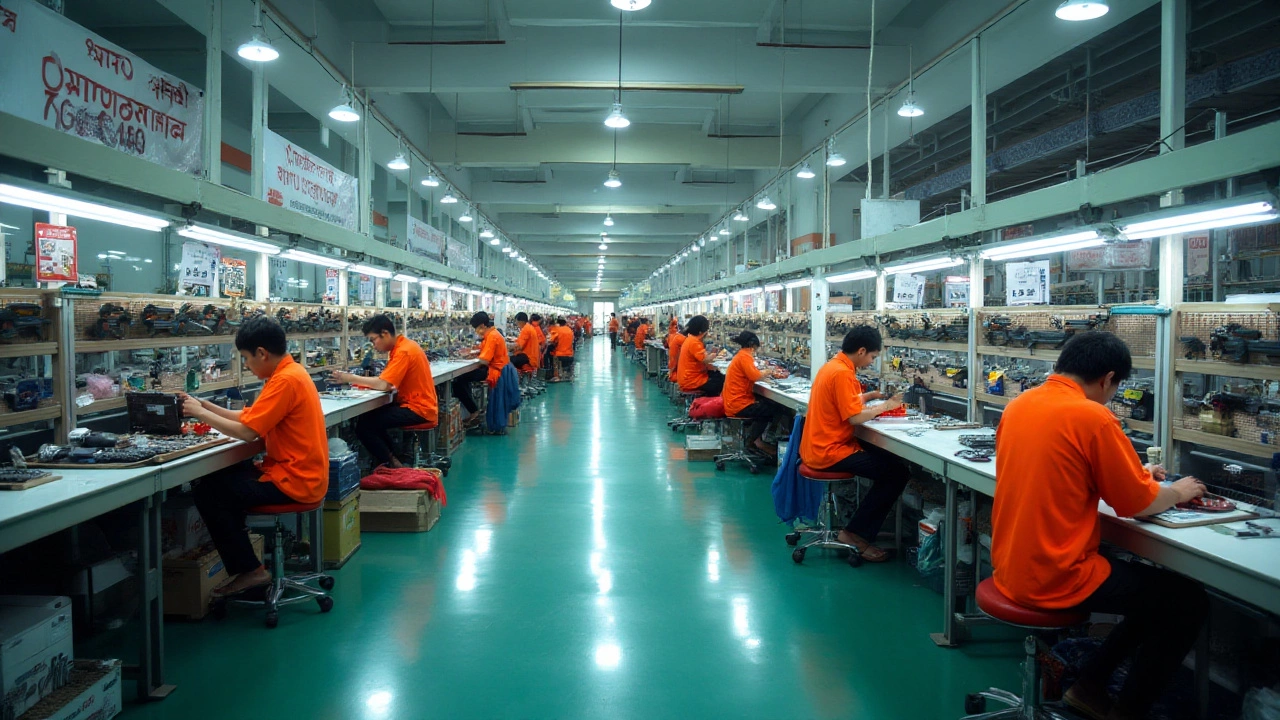In the dynamic world of electronics manufacturing, India has emerged as a promising player. With a robust growth trajectory, Indian manufacturers are increasingly looking west, eyeing the vast opportunities in the US market. This shift not only echoes the growing strength of India's technological expertise but also underscores the evolving nature of international trade.
Shipping electronics from India to the US involves navigating a maze of trade regulations, logistics challenges, and international standards. However, it's not just a story of hurdles. It's about the innovative solutions and strategic partnerships that Indian companies are leveraging to make this journey successful.
With the world becoming more interconnected, the bridges between countries like India and the US are being fortified daily by technology and trade. The tale of shipping electronics serves as a pivotal chapter in this narrative, marking a significant step in redefining India's place in the global electronics market.
- The Rise of Electronics Manufacturing in India
- Understanding Trade Regulations Between India and USA
- Challenges and Solutions in Electronics Shipping
- Choosing the Right Logistics Partner
- Future Prospects and Trends in International Electronics Trade
The Rise of Electronics Manufacturing in India
India's journey into the world of electronics manufacturing is nothing short of remarkable. Over the last decade, the country has strategically positioned itself as a burgeoning hub for electronics production. This transformation hasn't happened overnight; it’s the result of persistent government initiatives, strategic partnerships, and a vast pool of skilled labor. One driving force behind this growth is the 'Make in India' initiative, which was introduced to promote indigenous manufacturing. By offering various incentives like tax breaks and easier compliance norms, it has attracted significant foreign investment.
Despite facing challenges like infrastructure deficits and regulatory hurdles, India has made notable strides in establishing electronics manufacturing clusters. Areas such as Noida in Uttar Pradesh and Sriperumbudur in Tamil Nadu have emerged as hotspots, bustling with activity in producing consumer electronics, mobile phones, and other tech products. It's fascinating to note that India's mobile phone production exceeded 300 million units back in 2022, placing it right on the heels of China, the unchallenged leader in this segment. These statistics underscore India's prowess and growing capabilities in this dynamic industry.
The bright spot in this narrative is not just about quantity but also the quality and innovation pouring out from Indian factories. Companies are now embracing technology and automation to enhance efficiency and meet global standards. A notable example is the Electronics Manufacturing Cluster (EMC) in Bengaluru, which has become home to several start-ups and established electronics design firms, setting a new benchmark for innovation. This shift towards high-tech production is crucial in helping India cater to international demands, particularly from the USA, a significant importer of Indian electronics.
It's interesting to see how India's workforce is adapting to meet the needs of this burgeoning industry. Education and training programs focusing on electronics and electrical engineering are gaining popularity. Institutions and companies have collaborated to create curricula that align with industry demands, helping to bridge the skill gap. Consequently, this infusion of trained engineers and technicians is providing the backbone for the industry’s growth, ensuring that skilled manpower isn't a limiting factor.
One of the strategic moves by Indian manufacturers is embracing sustainable practices. With increasing pressure to reduce environmental impacts, companies are looking at eco-friendly production mechanisms. The emphasis on reducing electronic waste and recycling materials is gradually becoming a norm. Such steps not only improve India’s standing in the international community but are also appreciated by environmentally conscious consumers.
According to the Indian Ministry of Electronics and Information Technology, "By 2025, we anticipate India to be recognized as a global hub for electronics manufacturing, contributing over 25% to global production standards."
The rise in electronics shipping from India to international markets, such as the USA, reflects these strong manufacturing foundations. Indian companies are investing in state-of-the-art logistics, improving supply chain efficiency to reduce lead times, and enhance client satisfaction. This attention to detail is paramount in transforming India's reputation from a low-cost manufacturing destination to a reliable supplier of quality electronics.
Understanding Trade Regulations Between India and USA
Diving into the trade regulations between India and the USA is akin to navigating a complex labyrinth, one that is vital for anyone hoping to succeed in the electronics shipping sector. Both nations are heavily invested in ensuring that trade flows smoothly, but various rules and restrictions inevitably arise. For electronics manufacturers in India aiming to tap into the American market, familiarity with these regulations is not just beneficial; it's essential. Ensuring compliance with both Indian export laws and US import regulations influences not only legal standing but also affects the speed and efficiency of international trade.
One of the primary aspects to consider is the International Traffic in Arms Regulations (ITAR) in the US, which could affect certain electronic components. Though ITAR primarily focuses on defense articles, overlaps exist when dealing with advanced technology. Moreover, the Harmonized Tariff Schedule (HTS) codes specific to electronics must be clearly understood and applied correctly to avoid customs delays. On India's side, export requirements necessitate comprehensive documentation, clear invoices, and sometimes even pre-shipment inspections. This complexity demands that businesses stay agile and well-informed of any policy updates.
Trade agreements can sometimes lighten the regulatory burden. The Commerce Department in both nations frequently updates bilateral agreements, offering potential tariff reductions for specific electrical goods. According to a joint report by the Federation of Indian Chambers of Commerce & Industry and the US-India Strategic Partnership Forum, "The future of bilateral trade hinges on mutual adjustments of tariff regimes."
Exploring partnerships with seasoned logistics firms adept at navigating these waters can make the process considerably more manageable.Moreover, technology platforms such as Export Genius or Exim Data provide crucial insights into trade statistics and compliance, showing trends that help electronics companies strategize effectively.
Understanding foreign trade regulations doesn’t merely stop at laws and agreements. Cultural knowledge plays an understated yet pivotal role too. American business practices often emphasize speed and efficiency, requiring swift resolutions and prompt responses. Companies in India, consequently, need to sync their supply chain logistics to match these expectations. Lessons from companies successfully shipping electronics reveal that establishing warehouses or partnership hubs in strategic locations across the US often dispels a significant part of the logistical and regulatory load. The scope of regulatory understanding thus spans across legal, procedural, and operational parameters, each with its own intricate challenges and nuanced solutions.

Challenges and Solutions in Electronics Shipping
Shipping electronics from India to the USA isn't merely an oceanic journey but a multifaceted process that often challenges manufacturers at multiple levels. One of the key hurdles in this process is compliance with stringent import regulations. The United States has precise standards for safety, electromagnetic compatibility, and energy efficiency that electronics must meet. Ensuring products conform to these standards can become a significant bottleneck for manufacturers in India, especially for small and medium-sized enterprises that might not have the resources to manage compliance processes effectively.
Another towering challenge is the logistics of transporting fragile electronic goods across vast distances. As electronics often contain sensitive components like semiconductors, careful handling during each phase of transit is critical. Companies must ensure that they have a robust packaging strategy that minimizes the risk of damage due to temperature fluctuations, humidity, and physical shocks during transport. This becomes even more paramount when shipments go through multiple customs points, increasing the risk of mishandling.
Moreover, geopolitical factors play an influential role in international shipping of electronics. The fluctuations in trade tariffs, often influenced by political relations, can significantly impact the cost viability of shipping products to the USA. Keeping abreast of these changes is vital for Indian manufacturers to avoid unexpected cost surges. In recent years, trade agreements and alliances aimed at easing these barriers have been encouraging, yet the volatile nature of international relations remains a concern. To mitigate this risk, companies are advised to work with experts in trade law and international relations.
Innovative Solutions
Despite the challenges, solutions are at hand, driven by both technological advancements and strategic partnerships. Many manufacturers are increasingly turning towards smart logistics systems that offer real-time tracking. These systems assist not just in monitoring the transit of goods, but also in forecasting potential disruptions along the supply chain, thus allowing businesses to adjust plans proactively. In this domain, AI and blockchain technology are making significant inroads, providing unprecedented transparency and reliability in the supply chain landscape.
"Efficient logistics solutions are not just a choice but a necessity for international trade." - Rakesh Sharma, CEO of an esteemed logistics firm.
Collaborating with experienced logistics partners familiar with U.S. trade requirements is indispensable. Many logistics firms offer end-to-end solutions tailored for the electronics manufacturing industry, including consulting services to ensure compliance with U.S. regulations. These collaborations can mitigate risks and foster more streamlined operations from the outset. Indian manufacturers are also learning to leverage incentives offered by the Indian government through various trade schemes and subsidies, designed to promote export activities.
Strategically, forming joint ventures with local distributors in the U.S. can help Indian manufacturers better navigate market entry challenges, from understanding customer expectations to adopting efficient distribution networks for faster delivery. Such partnerships ensure both compliance and customer satisfaction, smoothing the path for electronics shipping between India and the USA.
Choosing the Right Logistics Partner
Navigating the intricate process of shipping electronics from India to the USA requires more than just a basic understanding of logistics. Finding the right logistics partner is critical to ensure that goods are transported efficiently, safely, and in compliance with all international standards. This decision can drastically affect the success of the entire operation, from cost efficiency to delivery schedules. The stakes are high, and choosing the wrong partner can result in delays, increased costs, and ultimately, damage to a company's reputation.
When evaluating potential partners, it is essential to consider their experience in international trade and their track record with electronics specifically. Electronics are often sensitive, high-value items, and not all logistics companies are equipped to handle such shipments with the care required. Additionally, the logistics provider should have a comprehensive understanding of both Indian and American trade regulations to help navigate the sometimes complex paperwork and compliance requirements.
"Selecting a logistics partner is not just about who can move your goods from point A to point B. It's about finding someone who can become an extension of your business and understands your unique needs," says Jonathan Smith, director at a renowned global logistics company.
The logistics partner’s technological capabilities are also a significant consideration. Firms with advanced tracking systems can provide real-time updates, enhancing transparency and allowing businesses to keep their customers informed. This capability is becoming more critical as consumers expect higher levels of service and communication throughout the delivery process.
Assessing Technological Infrastructure
An often-overlooked aspect is the software and technology that logistics companies use to manage their operations. Cutting-edge technology can streamline the shipping process, minimizing bottlenecks and reducing human error. Partners who offer online platforms for tracking shipments and managing logistics can significantly enhance operational efficiency. These systems should integrate easily with your existing systems, providing seamless data flow and enhancing decision-making.
Additionally, partners with strong relationships with customs authorities in India and the USA can facilitate smoother customs clearance. They can preemptively address potential issues and ensure that shipments are not unduly delayed at borders. This expertise is invaluable, especially when dealing with sensitive high-value shipments, such as electronics.
Logistics partners should also offer insights into optimizing shipping routes and methods which can save time and money. For instance, understanding when to use air freight for speed versus sea freight for cost savings can be incredibly beneficial. A skilled partner can provide this level of strategic advice, turning logistics from a simple supply chain function into a business advantage.
Financial Considerations
Working with a logistics partner implies not just evaluating their base fees but also understanding the total cost of their services. Transparent pricing models are essential, as unexpected charges can erode profit margins. It is crucial to understand all cost elements, including import duties, taxes, and insurance. Negotiating these elements upfront can lead to substantial savings over time.
Ultimately, the logistics partner you choose can make or break your endeavor to successfully ship electronics from India to the USA. The right decision involves a careful evaluation of experience, technological infrastructure, regulatory knowledge, and cost structures. In the rapidly expanding field of electronics manufacturing, taking the time to select the right logistics partner can result in enhanced efficiency and a robust competitive advantage in the international marketplace.

Future Prospects and Trends in International Electronics Trade
The landscape of international electronics trade is set for a transformative decade. As global demand for cutting-edge technology grows, the importance of seamless cross-border shipping becomes ever more pronounced. India stands at a particularly advantageous juncture, bolstered by its burgeoning reputation as a manufacturing powerhouse. Factors such as expanding the scope of the 'Make in India' initiative and favorable government policies aim to place the country in a prime position on the international stage. As more Indian companies expand their capabilities, they are not only catering to domestic needs but are also swiftly reaching global markets like the USA.
Innovation in logistics and supply chain management is playing a crucial role in optimizing the electronics shipping processes. Modern infrastructure, coupled with the advent of digital solutions like blockchain for tracking shipments, is minimizing bottlenecks and reducing lead times. The integration of technology in logistics is aimed at mitigating risks associated with damage or loss, ensuring that products reach their destination intact and on time. This technological evolution is crucial for sustaining and expanding trade, especially between continents as diverse and distant as Asia and North America.
The evolving trade dynamics are marked by a shift towards sustainability and eco-friendliness. As ecologically responsible practices take center stage, electronics manufacturers are joining global efforts to make production processes greener. These improvements are not only vital for the planet but they also resonate with environmentally conscious consumers. By adopting such practices, Indian manufacturers can enhance their appeal in the US market, where green certifications are increasingly becoming a deciding factor for consumers. This commitment to sustainability, coupled with competitive pricing, positions Indian electronics effectively in the global market.
Another pivotal trend is the acceleration towards digital trade agreements. As countries strive to enhance bilateral trade relations, formal agreements and protocols are evolving to support faster movement between borders. These agreements extend beyond tariffs and duties to include protections for digital content and intellectual property, establishing a framework for tackling legal challenges. As these frameworks evolve, they become a catalyst for greater participation from smaller manufacturers who previously found it challenging to venture into international markets.
Experts predict that the next decade will witness an incredible leap in the volume and diversity of goods exchanged between nations, catalyzed by the rapid acceptance of e-commerce and international online marketplaces. With platforms like Amazon and Alibaba progressively integrating localized operations, the seamless delivery of Indian goods, including electronics, into American homes is becoming a reality. Future market dynamics will heavily rely on these technological ecosystems, which enable new entrants to scale swiftly without incurring hefty overheads traditionally associated with distribution.
